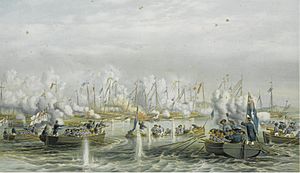Battle of Fatshan Creek facts for kids
Quick facts for kids Battle of Fatshan Creek |
|||||||
|---|---|---|---|---|---|---|---|
| Part of the Second Opium War | |||||||
 Advance of British boats during the naval battle at Fatshan Creek, by Oswald Walters Brierly |
|||||||
|
|||||||
| Belligerents | |||||||
| Commanders and leaders | |||||||
| Strength | |||||||
| 1,900+ marines & sailors 1 screw sloop 1 paddle steamer 7 gunboats |
1 fort 25 guns 100 war-junks |
||||||
| Casualties and losses | |||||||
| 13 killed (3 officers) 44 wounded (4 officers) 1 launch destroyed 1 gunboat damaged |
1 fort captured 25 guns captured 2 war-junks destroyed 70-80 war-junks captured |
||||||
The Battle of Fatshan Creek (佛山水道之戰) was a big naval fight that happened on June 1, 1857. It was part of a larger conflict called the Second Opium War. In this battle, the British Royal Navy fought against the Chinese fleet near the city of Foshan in China. The British wanted to destroy the Chinese ships before moving on to capture the city of Canton (which is now called Foshan).
Contents
What Was the Second Opium War?
The Second Opium War was a conflict between the British Empire and France against the Qing dynasty of China. It lasted from 1856 to 1860. The war was mainly about trade and how foreign countries were treated in China. The British wanted more trading rights and to be able to sell opium in China.
The Battle Begins
The British fleet was led by Rear-Admiral Sir Michael Seymour. He was a high-ranking officer in the British Navy. His goal was to find and destroy the Chinese fleet. This would clear the way for the British to attack and take over the city of Canton.
British Ships and Commanders
The British had a strong force for the battle. They used several types of ships. These included a screw sloop called Coromandel and a paddle steamer named Hong Kong. They also had seven smaller gunboats. These gunboats were named Haughty, Plover, Opossum, Bustard, Forester, Starling, and Staunch.
Many smaller boats from larger British ships also joined the fight. These boats came from ships like Calcutta, Nankin, and Raleigh. Each of these ships and boats had their own commanders, working together under Admiral Seymour.
Chinese Defenses
The Chinese forces had a fort defending the area. This fort had 25 guns ready to fire at enemy ships. They also had about 100 "war-junks." War-junks were traditional Chinese sailing ships used for fighting. They were often armed with cannons.
The Fight at Fatshan Creek
On June 1, 1857, the British ships moved into Fatshan Creek. They quickly found the Chinese fleet and the fort. The battle was intense, with both sides firing their guns. The British used their powerful naval guns to attack the fort and the war-junks.
The British forces were very effective. They managed to capture the Chinese fort. They also took control of the 25 guns that were there. During the battle, two Chinese war-junks were destroyed. Many more, between 70 and 80, were captured by the British.
Results of the Battle
The Battle of Fatshan Creek was a clear victory for the British. They successfully destroyed or captured most of the Chinese fleet. This opened the way for them to move towards Canton.
The British had some losses, but they were much smaller than the Chinese losses. Thirteen British soldiers and sailors were killed, and 44 were wounded. One British launch (a small boat) was destroyed, and one gunboat was damaged.
This victory was an important step for the British in the Second Opium War. It helped them continue their advance into China.
Gallery
See also




